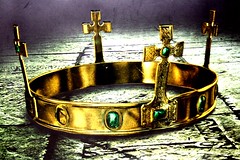Anyone find it apropos that George R.R. Martin’s initials nearly spell out the tone of his books? As the reigning king of postmodern epic fantasy, GRRM has founded his throne on grimly plotted tales where intricate intrigues meet a willingness to rub out any character, no matter how likable. A tongue-in-cheek bumper sticker sums up his uncompromising approach: “Guns don’t kill people. George R.R. Martin kills people.” Of course, uncompromising really isn’t the right word choice, is it? Perhaps evangelistic would be better, because Martin seems to like to preach to readers that the world is (in the words of Stephen Hunter) “a stainless steel rat trap with a 4,000 pound spring.” That’s part of the reason why I’ve never really gotten into the A Song of Fire and Ice series. Sure, critics like to bring up the fact that the books are modeled after The War of the Roses, but having a historical basis doesn’t necessarily imbue a work’s themes with greater verisimilitude. Betrayal, murder, and rape are no more real than valor, love, and sacrifice. Chinese-American author Ken Liu seems to understand this. His debut novel, The Grace of Kings, is equally committed to both virtue and violently executing figures that readers have come to know and love.
The archipelago of Dara has never been a peaceful place. The six nation-states situated on the big island have squabbled for centuries, their conflicts fanned to a fever pitch by a petty pantheon of eternally squabbling gods. But that was before the arrival of Emperor Mapidéré, a Xana king with a grand vision for unifying the islands through the military might of his fleet of airships. And he succeeds, but the resulting empire has more in common with Hoeryong and Piaskowy than Plato’s mythical republic. An iron-handed centralized government. An impenetrable bureaucracy. Cultural colonialism enacted by royal diktat. Plenty of people have reason to hate Mapidéré—as do the gods themselves. Divine disagreements are about to engulf the entirety of Dara in pitched conflict, and the contest for conquest will come down to two men: Mata Zyndu, a ferocious giant of a man who’s the last heir of his noble clan, and Kni Garu, a small-time gangster whose criminal deeds shroud his surprisingly gracious temperament.
The first thing you’ll find after opening The Grace of Kings is a map—a big map awash with colors and names, everything neatly drawn to scale and put in its proper place. Soon after, you’ll discover a pronunciation guide and then three full pages of major characters. None of these things reassured me. I typically read at night, yawning my way through chapters, and the thought of trying to keep a skein of subplots from getting tangled typically just makes me more tired. But Liu does something rather brilliant: He structures the book as a series of interlocking vignettes with the main characters popping into and out of them from time to time. Make no mistake, The Grace of Kings is a beast of a book, so chock full of detail that only the most obsessive readers will manage to puzzle every piece together. But it’s also remarkably easy to page through a chapter after a long day, a refreshing development in a genre whose tomes too often turn plodding after the first few chapters. I found the book’s themes equally engaging. Not only does Liu give even the most seemingly despicable characters a sympathetic twist, often making them downright heroic in unexpected ways, the proceedings also appear to hint that fiscally restrained, democratic, laissez faire governments best respect the needs of the common man. Less welcome is the idea that infidelity can make for a happy marriage or that Mapidéré might have been justified in forcibly quashing local distinctives. Of course, The Grace of Kings is only the first entry in the series, so Liu has plenty of space to unspool such musings even further. Add in epic fight scenes, magnificent shifts in plot, and the surprising sacrifice of character after character, and Grace is fantasy fit for royalty.
(Picture: CC 2013 by jason train)
Wednesday, June 22, 2016
Subscribe to:
Post Comments (Atom)



No comments:
Post a Comment